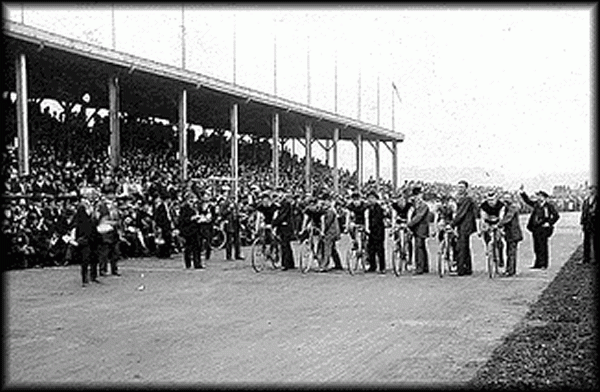
No inventor or country can single-handedly claim to have invented the bicycle; it was invented and reinvented in many places over a period of many years.
In 1817, Germany's Baron von Drais de Saverbrun invented the Draisienne, (also "draisine" or "hobby horse") a steerable bicycle. It was almost completely made of wood, and had no pedals. Riders propelled it by pushing their feet against the ground. In 1860, a model called the Michaux Velocipede became the world's first mass-produced riding machine. Designed by France's Pierre Michaux, he came up with his design when a customer brought a Draisienne in for repairs. After his son tried riding it and had difficulties with his feet on downhill roads, Michaux came up with the idea of connecting crank arms and pedals directly to the front wheel as a means of propelling the bike. In 1865 in Connecticut, Pierre Lallement rode a distance of several miles and performed the very first "header" (flipping over the handlebars) on his bicycle. He was granted the first bicycle-related U.S. patent in 1866.
It seems that people have always held a special place in their hearts for sports stars of the day; history has seen an ongoing cycle of esteemed athletes.
In a time long before the names Jordan, Gretsky, or McGuire were associated with greatness, people began to idolize a group of athletes who were fun to watch and enjoyable to cheer for. These athletes were bicycle racers, and they became some of America's earliest sports heroes.
Since the automobile didn't catch on until the beginning of the 20th century, it is easy to understand how and why the bicycle became so popular. Throughout the late 1800s, new models and materials were constantly being designed and tested. Bicycles provided people with a means of travel, recreation, sport, and newfound freedom. The League of American Wheelmen, or L.A.W., was established in 1880 as a national chapter of bicyclists. Known then as "wheelmen," cyclists were challenged by gravel and dirt roads, and sometimes given problems by horsemen, wagon drivers, and pedestrians. In order to improve conditions for themselves, the early leaders of bicycling came together and lobbied the government for more paved roads and assistance in ending the antagonistic acts of other road-users. Formally united in 1880, the League's mission has continued for more than a century. Today, the L.A.W. is called the League of American Bicyclists.
Bicycle clubs sprang up everywhere, and gave cyclists a chance to gather and socialize, share their interest in the sport, and even race competitively. Members proudly wore the badges, buttons, and pins of their clubs at meets and races. Before baseball cards came about, racing cards were sold in cigarette packs and featured the latest popular wheelman. Here are just a few of those heroes:
Charlie Miller was a German immigrant who lived in Chicago. Miller was considered the king of the "single six," a race in which a single rider sometimes pedaled as much as twenty hours in one day. Many people considered this a grueling test of racing ability, but he excelled at it. The single six was eventually outlawed.
Englishman Thomas Stevens took a bike trip around the world in the 1880s. The feat took two years and eight months to accomplish, and Stevens published installments of his colorful adventures along the way, gaining fame and the nickname, "The King of the Cycling World" for his incredible journey.
Two more "stars" of bicycle racing were George M. Hendee and W.A. Rowe. Hendee was graceful and handsome, and quickly became very popular. He was well known both in the society of cyclists and among racing fans. When W.A. Rowe, another rising star, upstaged him in a Massachusetts race in 1887, it was said that the people in the grandstands wept to see Hendee's champion status taken from him.
In the 1890s, A.A. "Zimmy" Zimmerman was America's first international athletic star. He was a fun-loving, agreeable character from New Jersey who could get three hours of sleep the night before a race and then go out and break a time record. Zimmerman changed amateur racing from a sport for the wealthy to a sport with universal appeal. He appeared in advertisements for bicycle companies, and people were fascinated with his effortless victories. Zimmy was known for his short bursts of incredible speed, holding back until the last lap when he would surge forward to defeat his competitors.
Marshall "Major" Taylor was an African-American who became one of America's first world champion athletes. Taylor was discovered at age 13 in Indiana, and won a racing medal at the same age. He faced extensive racial prejudice, and was even banned from racing in various American cities because of his color. In 1901, Taylor began a European tour of fifty-seven races, of which he won forty-two. Marshall Taylor was the first African-American world champion in any major sport.*
*[From The American Bicycle. Pridmore and Hurd, 1995.]
Note: The objects pictured above are part of The Franklin Institute's protected collection of objects. The images are ©The Franklin Institute. All rights are reserved.











